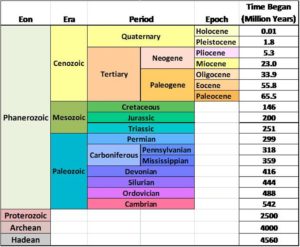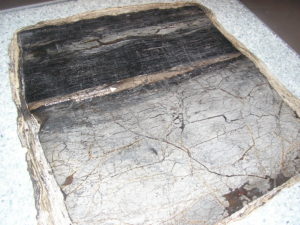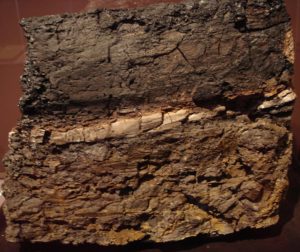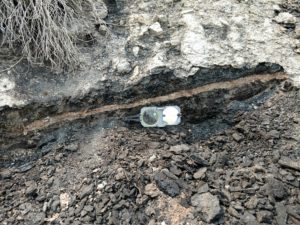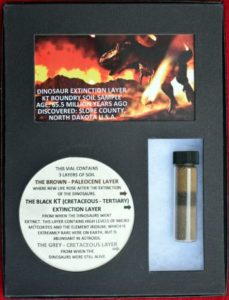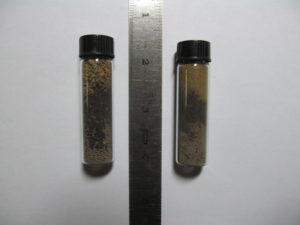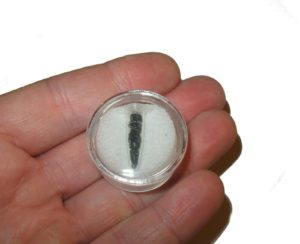Lately, I have been trying to wrap my head around the concept of the K/T Boundary. According to evolutionists, the K/T Boundary is a known geologic, physical, reality. It is defined as a physical marker for an ancient extinction event in earth history. This “marker” is said to be something that can be actually seen in the rock record* and separates the Mesozoic Era from the Cenozoic Era of the evolutionary Geologic Column.
A Representation of the Geologic Column Mental Abstraction
The basis for the name of this marker as the K/T Boundary is that it also separates the Cretaceous Period from the Tertiary Period in the Geologic Column. If you look at the chart above you can see that there are other periods that start with the letter ‘C’ so the boundary is K/T instead of C/T. To confuse things even more the “powers that be” fairly recently renamed the boundary to K/Pg to represent the separation between the Cretaceous Period and the Paleogene Period. I will use K/T in this article since this terminology is more commonly seen in the existing literature.
I have written previously at some length that the Geologic Column and its interpretive cousin the Geologic Timeline do not represent observable reality, but are instead mental abstractions developed by evolutionists to attempt to sell the idea of organic macroevolution in the rock record. For example, see in books I have written, as follows:
- The Creation Dialogues—2nd Edition, pp. 7-8.
- Discovering the Animals of Ancient Oregon, pp 92-104.
- Fossils: Description & Interpretation within a Biblical Worldview, p. 3, 5-6, 243.
I personally have never actually seen the K/T Boundary in the rock record. I have seen photographs that are identified as showing the K/T Boundary. The four photos immediately below this paragraph are identified, by those who took them, as being of the K/T Boundary. Usually they also identify the photos as representing the extinction event that wiped out the dinosaurs.
1. K/T Boundary section from Alberta, Canada
2. K/T Boundary section from Wyoming, (credit Eurico Zimbres)
3. K/T Boundary section from Hell Creek formation in Montana
4. K/T Boundary section from Garfield County, Montana
I will say that I believe I have seen other layers in the rock record similar to these that were not identified to be attributed to the so-called extinction event—at least to my knowledge. In the above four examples we can observe the following:
- In each example photo the sandwiched K/T layer itself, the layer above the K/T layer, and the layer below the K/T layer, all are hardened rock.
- The K/T layers are all relatively thin but not all have a measured thickness noted.
- For photo 1: the colors of the layers (in the order K/T layer/then layer above/then layer below) are light brown/black/light gray.
- For photo 2: the colors of the layers are light gray/dark brown/light brown.
- For photo 3: the colors of the layers are light brown/ black/black.
- For photo 3: the colors of the layers are pinkish brown/ black/brown.
The reason for documenting these observations is to point out that the K/T boundary evidently cannot easily be determined just by looking at it. It seems to vary in makeup and color from location to location. From my research it seems that the most important determining factor for identifying the K/T Boundary is that no dinosaur fossils can be found above the boundary layer. They can only be found below the layer. This is because the K/T Boundary, by definition, represents the extinction event that wiped out the dinosaurs. I hope you can see the circular reasoning involved here. Remember too, that for evolutionists, fossils are always the final determiner for the age of any and all rock layers.
Over the years I have noticed that geological and fossil suppliers have offered “Dinosaur Extinction Event Layer K/T Boundary Samples” for sale to non-scientists. One sample kit is shown in the image below where the three layers in the vial are all soil particles instead of hard rock. This sample comes with an explanation card that explains how the K/T boundary layer denotes the dinosaur extinction event.
The interpretive card also explains what the defining factors are for determining the K/T layer. These are “high levels of micro meteorites and the element iridium.” In my research for this article I found that the iridium factor is the current favorite evidence for secular scientists in determining the layer. This is because most scientists believe that there is more iridium in asteroids and meteorites than there is in earth rocks. By the way, I bought two of the 5/8” diameter X 2 3/8” long vials of the K/T layer soil sample and they are shown in the photo below. The vials have fine and medium sized grains of soil of three different colors (The K/T layer is the darkest color, unlike the samples in photos 1-4 above). The soils have been poured one upon the other into the vials. In my samples, in the photo below, the layers in the vials are no longer defined due to the fact that they were shaken when they traveled to me by US mail from California.
Purchased vials with soils from K/T Boundary-location not specified by seller.
These K/T Boundary vials would have no purpose other than attempting to be convincing proof of the existence of the dinosaur extinction event. However, if a person with an open mind would consider the likely methods for collecting the samples, the operation for filling the vials, and the fact that the layers within the vials are not static, then the belief in the authenticity would quickly vanish.
These K/T Boundary samples are also available as small pieces of rock like those seen in the two images below. I will leave it to the reader to decide if rock samples like these are more convincing for proof of an extinction event than those made up of the soil particles.
Rock piece sample of the K/T Boundary
Rock piece samples of the K/T Boundary
Since the iridium is thought to be so important for determining the K/T Boundary, let’s look at it in more detail. Iridium (Ir) is a chemical element with a density of 1,400 pounds per cubic foot. This compares to iron (Fe) with a density of 490 pounds per cubic foot. At standard temperature and pressure, iridium is solid and is very hard and brittle, with a silvery-white color. The only denser metal is osmium (Os) with a density of 1,405 pounds per cubic foot.
As I mentioned earlier, iridium is currently thought to be found in meteorites at higher levels than it is found in the earth’s crust. For this reason, when iridium was found in the K/T boundary, it was defined as a marker for the dinosaur extinction event predicted by the Geologic Column mental abstraction—where dinosaurs are not to be found after the Cretaceous Period. (Yes, I know this is circular reasoning.) The so-called “smoking gun” for this extinction event is currently a geologic feature called the Chicxulub Crater in Mexico. Literally thousands of articles have been published in science publications about the extinction event and the Chicxulub crater. Creationist Timothy Clary has written a research article, “Do the Data Support a Large Meteorite Impact at Chicxulub?” (Answers Research Journal, 10(2017): 71-88). In this article Dr. Clary makes the case that there was no Chicxulub meteorite impact.
That conclusion being true or not, how would a creationist explain the iridium found in K/T layers? Personally, I would explain the layer itself in the same way the layers above and below would be explained by creationist geologists. They are the result of the Genesis global Flood about 4500 years ago. Also, volcanoes produce iridium as well, and most creationist models for the Flood include massive amounts of volcanism. So, the Flood can explain the layer and the iridium.
The Bible tells us that dinosaurs were on the ark. We know this since we know that dinosaurs were animals. That fact and the historical evidences of dragons (now called dinosaurs) abounding well into the Middle Ages, support the biblical idea that dinosaurs did not go extinct 65 million years ago as the secularists hypothesize. Dinosaurs evidently came off the ark and were unable to thrive or adapt due to various factors. Probably the major factor was the deleterious actions of man toward them. Some people today still believe they have evidence that dinosaurs (and I do not mean birds) are still alive in the remotest parts of the earth. Remember that according to the Bible, birds were created on day 5 ahead of the dinosaurs, and so the dinosaurs could not have evolved into birds—they already existed when the animals came on the scene.
In 1993, an international team of paleontologists from the American Museum of Natural History and the Mongolia Academy of Science made some great fossil discoveries in the Gobi Desert (at the Flaming Cliffs) in Mongolia. Upon their return the Americans reported on some of their finds in the December, 1994 issue of Scientific American (vol. 271, pp. 60-69). Consider this quote from that article:
“…Gobi rock sequences are entirely sedimentary, without even traces of volcanic rocks. Thus, geologists cannot determine the age of these strata by analyzing their proportions of radioactive isotopes. In yet another ironic twist, the rocks of the Gobi appear to be missing precisely those strata that currently hold the greatest public interest: no sections found thus far include the Cretaceous-Tertiary (K/T) boundary, when the dinosaurs became extinct. Although the Gobi is richly endowed with early Tertiary mammal faunas, there seems to be a gap of at least several million years between these and the late Cretaceous dinosaur faunas. Whatever cataclysm wiped out the dinosaurs (and many other species then on earth), its mark on Central Asia seems to have been erased.”
So we see here another example that shows that the secular age of fossils is not determined by the rocks in which they are found. Instead, their ages are determined by their relative location in the Geologic Timeline abstraction. The circular reasoning around all of this drives us to understand the fact that the fossils will always win any evolutionary argument over the age of a fossil or any layer of sediments.
Finally, there are still questions I am not able to answer about the K/T Boundary, including the following:
1. How often are layers around the world that are assigned as K/T actually tested for iridium? Are adjacent layers to assigned K/T layers tested for iridium?
2. How will evolutionists explain dinosaur fossils found above the K/T layer? For decades no dinosaur fossil was found closer than 10 feet to the layer. Recently, they have been reported to have been found within six inches of the layer. And this is according to evolutionist reports. It is my guess that dinosaur fossils have already been found above the layer, but not reported, because of the damage it would do to the evolutionary paradigm. Creationists understand that the global Flood cataclysm could have caused many abnormalities regarding the sorting of fossils, such as dinosaur fossils in unusual places in the rock record.
J.D. Mitchell
*Note: I have accepted the following definition for the rock record, and I use this terminology whenever appropriate: “‘Rock record’ is a descriptive term for those portions of the earth’s crust open to human examination and ‘geologic column’ is the interpretation of the rock record by means of assumptions about deep time, evolution, and the continuity of depositional process operating in modern environments.”
Rock Record definition is from The Geologic Column – Perspectives within Diluvial Geology, CRS, 2006, editors Reed and Oard, p. 127.
